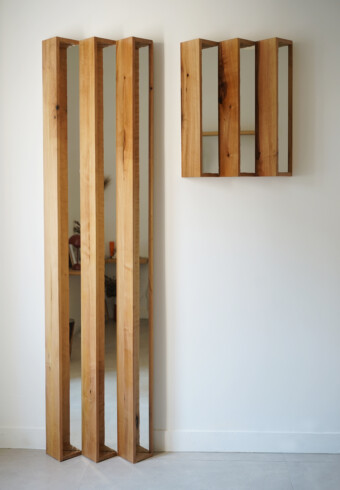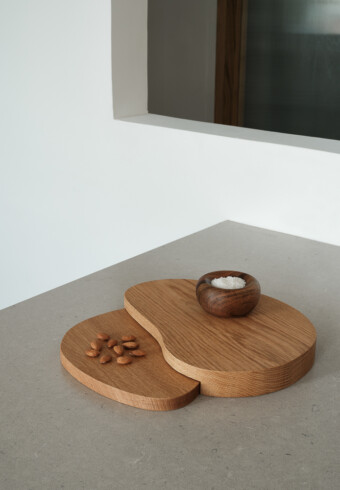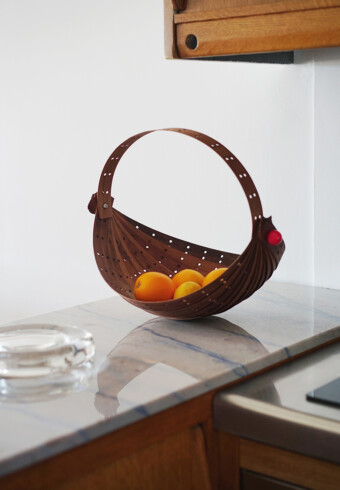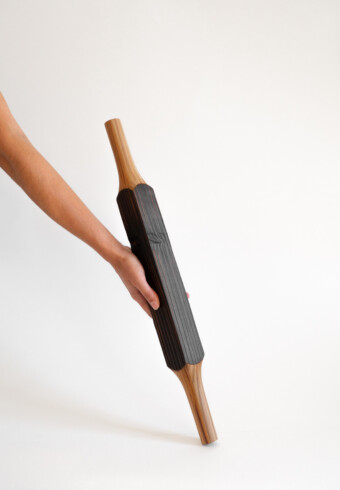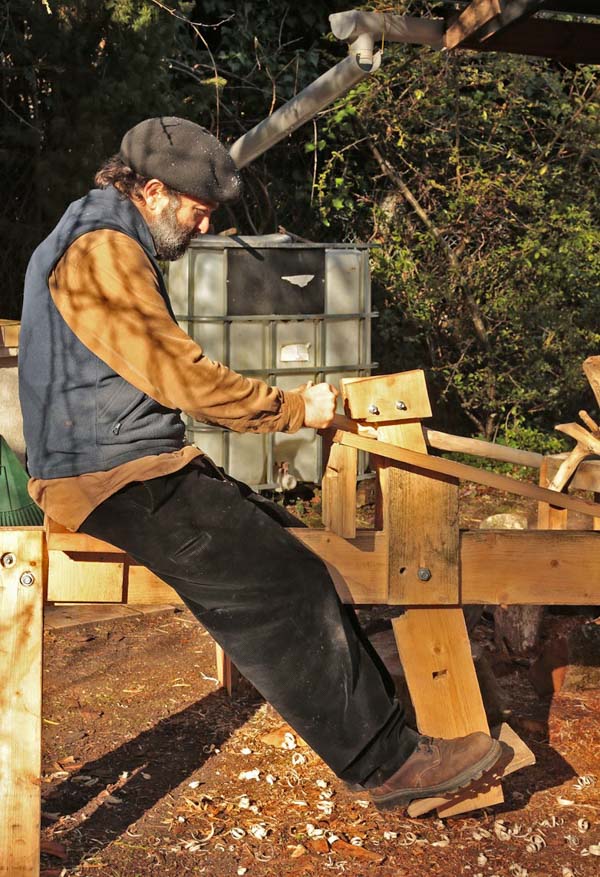
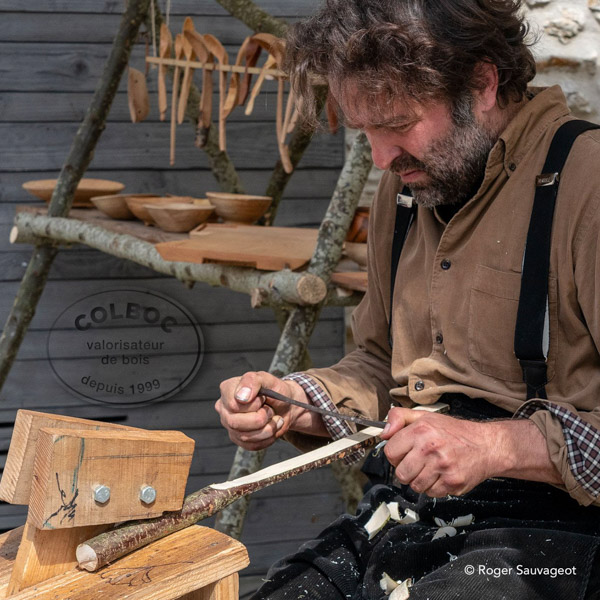
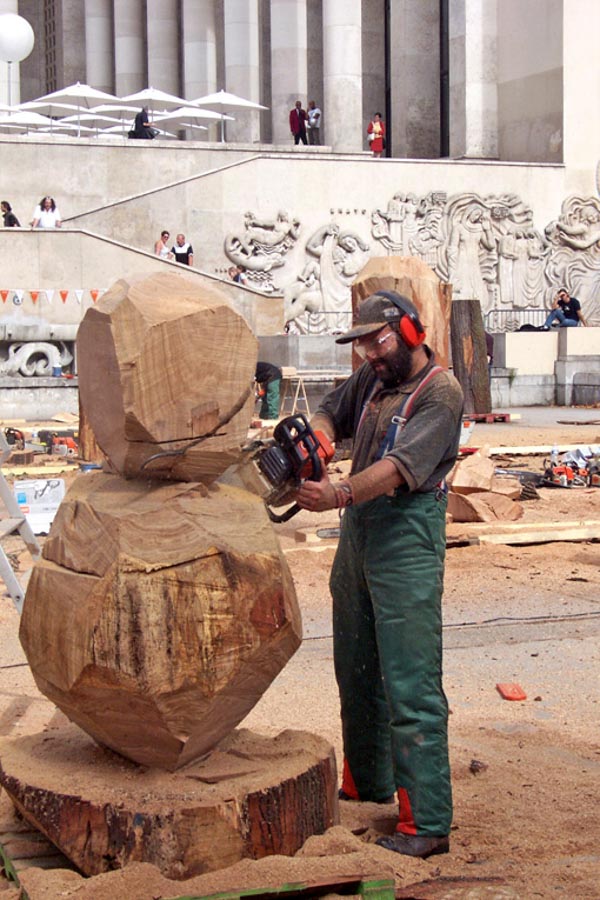
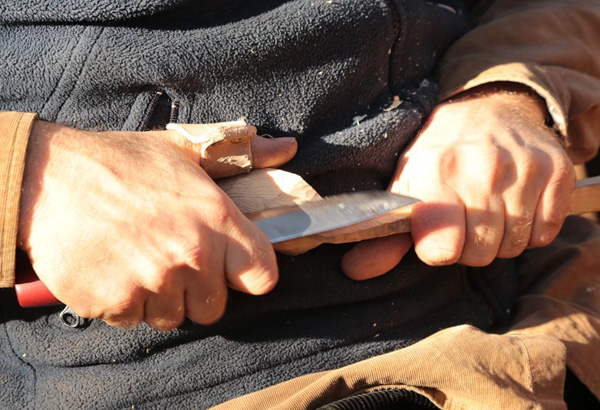
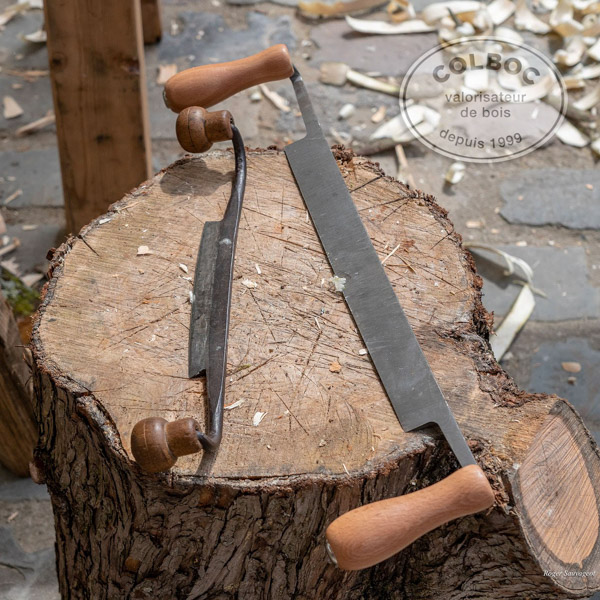
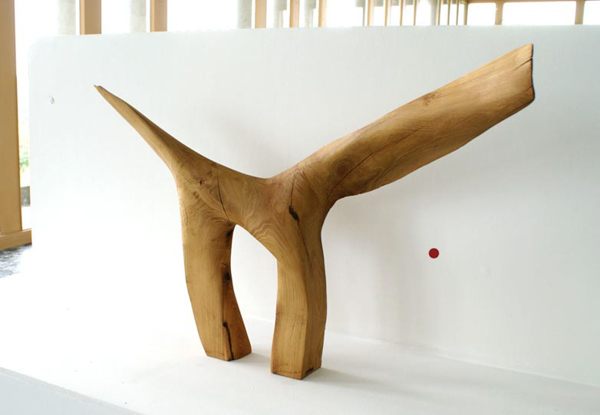
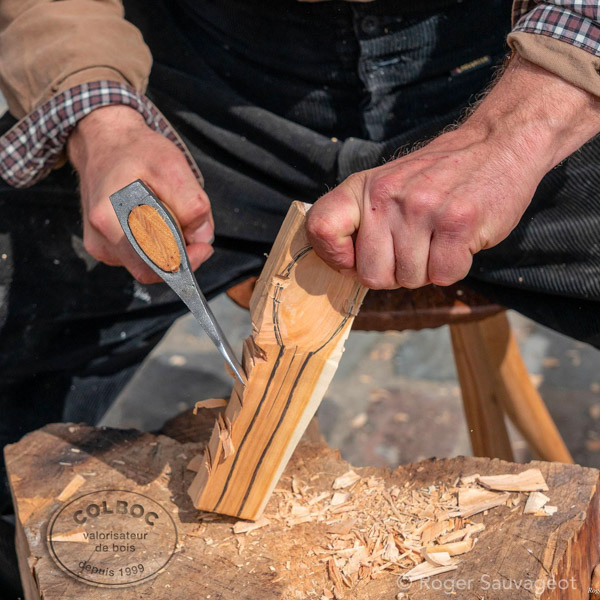
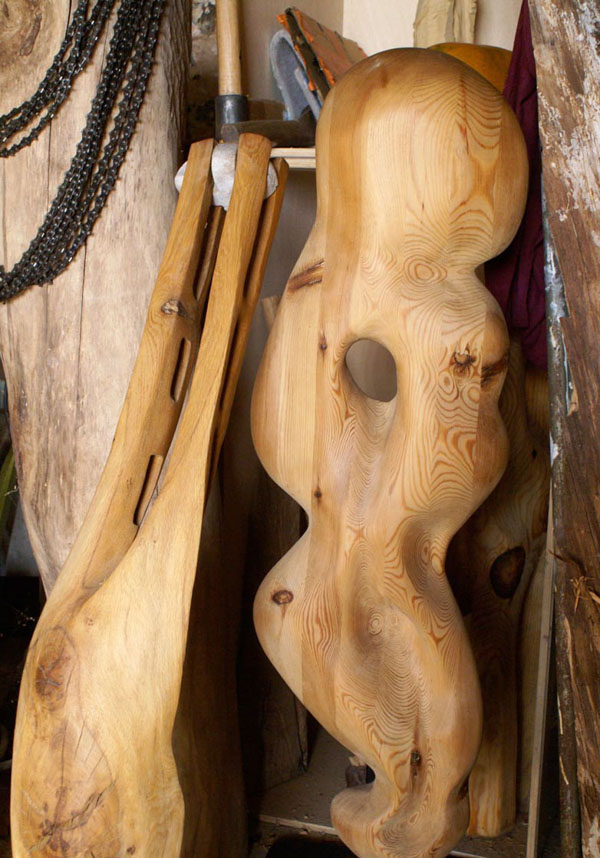
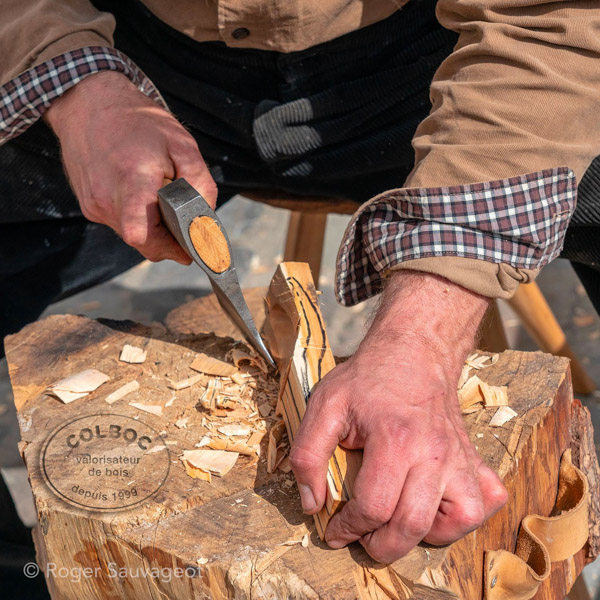
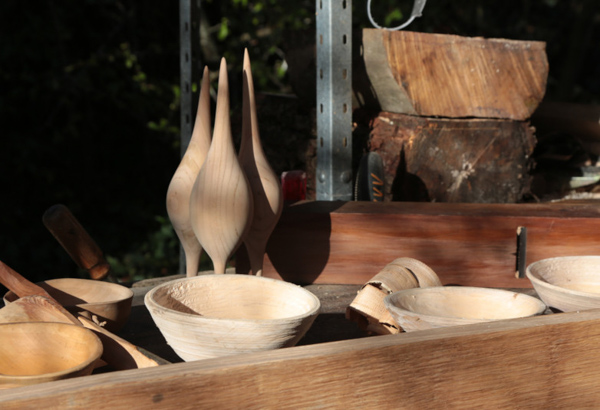
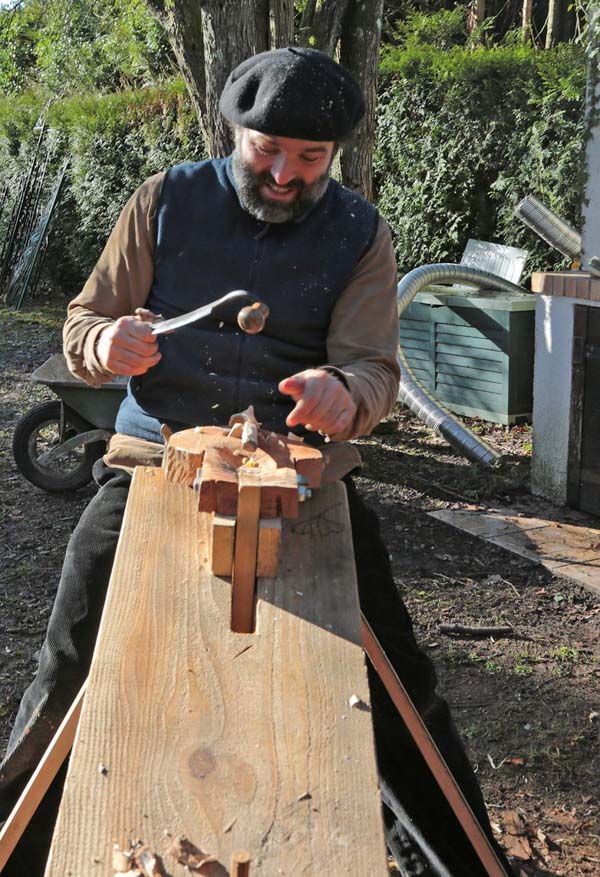

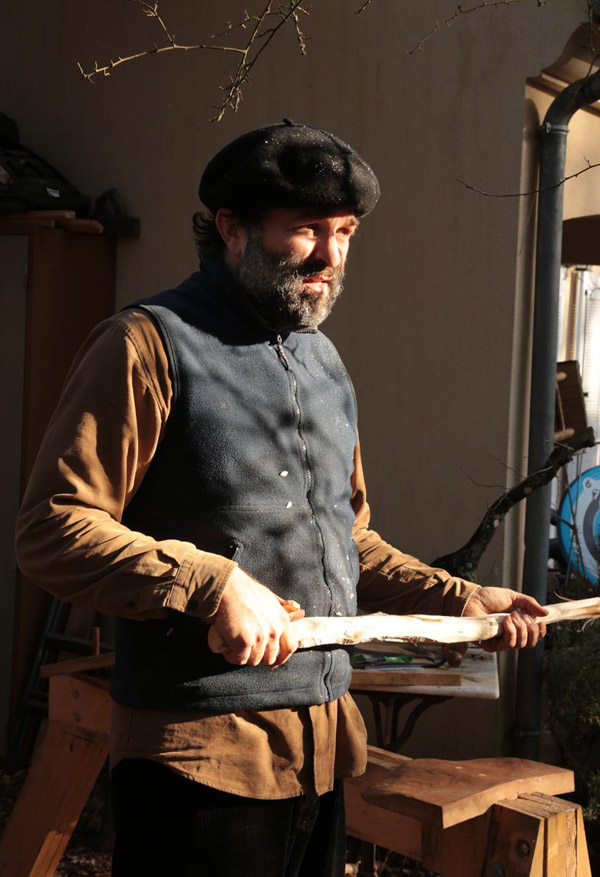
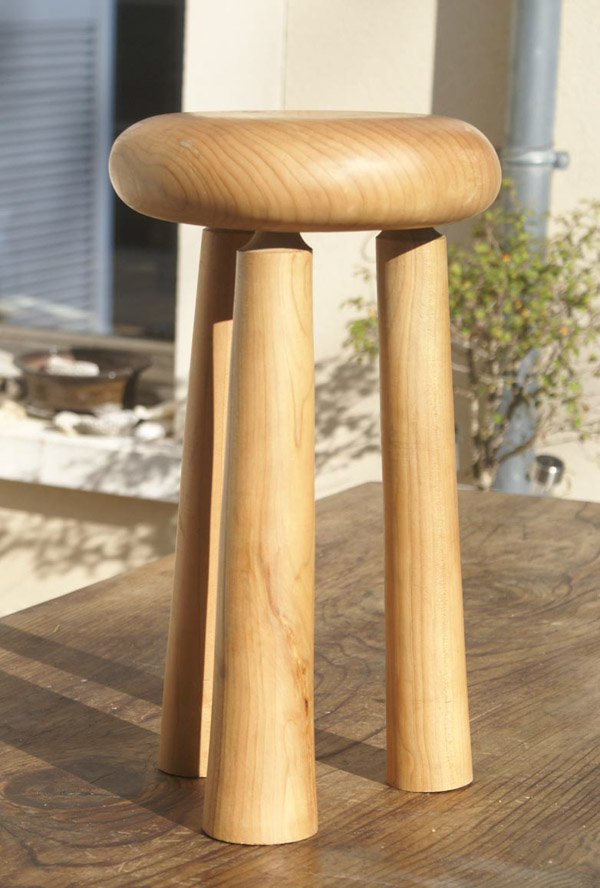
Julien Colboc

In the heart of the Fontainebleau forest, Julien Colboc sculpts wood. Trained at the École des Arts Décoratifs in Paris and more recently in carpentry and cabinet-making, he qualifies himself as a “valuer of wood”. Shaping monumental sculptures or smaller pieces, Julien likes to keep certain traditional techniques in his practice, mixed with more modern tools. Through this process, he comes to feel closer to the material. Meet.
Tell us about your background.
I graduated from Applied Arts in Graphic Design (ENSAAMA) and Decorative Arts from Paris in painting and sculpture. So I have a rather artistic profile. When I entered the Decorative Arts wood workshop in 1999, I rediscovered the atmosphere of my great-grandfather's workshop. I became addicted to wood. I then started my first sculptures. I was already working with rough branches, chopped wood, offcuts from workshop waste, while some furniture students wondered about my practice. In the same year, a violent storm uprooted and smashed many trees, which allowed me to have plenty of raw material. I also started by digging in construction dumpsters to recycle red wood scraps. Upcycling before the hour in a way. This is how I define myself: Wood valuer. During the same year, I was able to participate in a monumental sculpture project on the banks of the Seine involving 6 oak trunks 1 meter in diameter with Daniel Pestel, the artist involved. I then met my first chainsaw and have been working with it ever since. My graduation diploma was on an oak flotation project on the Seine and the construction of a floating structure at the foot of the BNF. I was already in the process of promoting the wood industry. Since 2001 I have been practicing the two professions of graphic designer and sculptor.
How do you reconcile these two activities?
In 2004 I designed my first project combining graphics and woodcarving. I suggested to the Hauts-de-Seine department to recycle lime trees felled in an alley in the Parc de Sceaux. I carved out pieces of boat frame emerging from the raw trunk. A graphic route of 12 panels explained how the boats were carved out of trees under Colbert. He had written an edict in 1669 which limited the cutting of trees near rivers, streams and coasts. He wrote in old French: "It will be necessary that the forests are subscribed". Support, sustainable… He was already aware of the concept of sustainable development. It does not date from yesterday! Subsequently I designed and carried out other educational projects in the eco-district of Pyla in 2016, the headquarters of Picard in 2019, or in the Community of municipalities of Val Briard in 2020. In 2006 I been contacted by the Palais de Tokyo in Paris to set up a chainsaw sculpture competition. I contacted the loggers of the City of Paris so that they could deliver 12 oak logs to us from the Bois de Vincennes. They were installed in the courtyard, well known to skateboarders. For 2 days the chainsaws hummed to transform the material into sculptures. After a residency at the Halle Papin in Pantin, we moved to Fontainebleau in 2018, at the edge of the forest to develop my various activities: wood sculpture, crafts, filming, internships, public interventions, school and extracurricular interventions. , graphics… My business model, a key subject that I share with my interns, is based on several complementary activities. This is what gives me a very useful resilience these days.
What do you look for in the pieces you create?
When I create a work I try to appease, do good in softness and curves and find the child who is in me. It can take years to find the right shape, the right balance. And it also takes a lot of trial and error. But it can also be very fast. Each successful sculpture is a victory in the face of disenchantment with the world we live in.
You work with green wood. Can you tell us about this type of wood?
In 2011 I got tired of working with wood, being kept away from the material by power tools because of their vibrations, noise and dust. I got interested in green woodworking via social media and online videos thanks to #greenwoodworking. Green wood is freshly cut wood that is still “green”. It is easier to cut with a knife or ax than dry wood. The ancients worked on it a lot. For example, the frames were cut from green wood. The green woodworking movement is important in England in particular. There are also a lot of followers in France, and annual meetings in Brittany and Corrèze. Among other things, it allows us to rediscover the wealth of our heritage of regional tools and practices. Little by little I introduced into my practice tools such as the ax, the plane, the knife… It is sometimes faster to strip with a chainsaw and to rough with an ax / adze. Then I started carving spoons and bowls. So I developed a second practice of woodworking. Very quickly I felt the need to share the pleasure of old-fashioned woodworking through internships in the forest or in my garden on the edge of the forest.
You enjoy both learning and transmitting, why is this important to you?
I'm not the best spoon tailor but I take great pleasure in sharing my passion and passing on what I know. It is moreover by transmitting that I learn. I have developed a pedagogy which starts from raw wood and the simplest gestures thanks to axes and planks to finish with the knife. I really like, among other things, working in the districts of Trappes or Pantin where the children are full of energy. I make them climb on donkey benches, a sort of bench-shaped bench-shaped bench, to reconnect them to themselves. I also offer courses over one or two days for adults of all levels. The tools that I use and that I make available to the trainees allow everyone to familiarize themselves with manual work. They split a still green wooden trunk with a divider and a mallet - tools of the bardelier, the wood tile cutter - before cutting with a very sharp ax or a plane. I then observe and correct the self-control and the tool by directing each and everyone towards a work in full consciousness. We respect each other and we respect the wood. Then the body is ready to cut the wood properly. I draw the trainees' attention to the need to breathe. The breath fully participates in this activity. It is even central in the dynamism necessary for the effort and the perpetual energetic renewal. A 3-beat jazz rhythm then sets in. This music carries the trainees until midday. The afternoon will be more oriented towards finishing with the plane and the knife, in the peace of the garden. They intuitively rediscover the innate skills of their bodies, more suited to working with wood than standing in front of a screen. My initiations aim to give a taste for woodworking by transmitting a passion and an ancestral know-how and of the future in the hope of creating vocations. The participants leave with notions of autonomy, fundamental in my teaching: sharpening your blade, retyping old tools, recovering your wood, making your own work benches, being part of a real social network and not only virtual.
This year, I myself took courses to deepen my technique: cabinetmaking, carpentry, woodturning ... Others are planned such as the pole lathe or forge. I never stop learning and I have an incessant need to pass on. We are all in a process of continuing education. My family also has an important place in this learning. My wife's unwavering support for 21 years is a strength that I cannot do without. And the joy of now seeing my children running in the workshop, carving wood or testing my sculpture-games fills me with joy.
Who and what inspires you ?
I need to immerse myself an hour a day in the Forest of Fontainebleau. I unload my excess of energy there and find there the wonder of little Julien whom I seek to find, not to lose. The trees help me a lot. The padded silence of the moss floors too. Inspiration then comes from silence and emptiness. David Nash and Guiseppe Penone are artists who marked me a lot as a student, as well as the sculptor friends of my architect grandmother: Pierre and Véra Székély, Henri Guérin, Marino Di Teana… And today Instagram is a beautiful one. source of inspiration, just like half of the artisans who exhibit alongside me on this site.
Can you tell us about the Pine link piece that you present at the OROS Market?
It is valued wood, a fall from a log house built in Normandy. The initial inspiration is a large tenon mortise framing. I realized the same principle on a larger scale for the playground of the eco-district of Pyla in La Teste de Buch. Modular, it is a real pleasure to take it in your hands and orient it as you wish.
Twitter account @colboc













- Photographer: Photos 1, 4, 6, to 10, 12, 14, 15 Marie-Lys Hagenmüller | Photos 5, 7, 9 Roger Sauvageot | Video Olivier Lattuga
- Location: Fontainebleau, France
- Website: https://www.juliencolboc.com
Share
